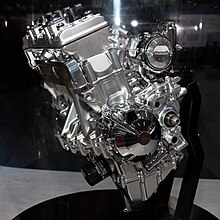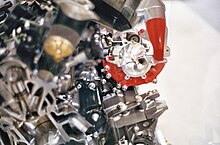Kawasaki Ninja H2 Model Specifications
Kawasaki Ninja H2
From Wikipedia, the free encyclopedia
This
article is about the supercharged four-cylinder motorcycle announced in
2014. For the 3-cylinder motorcycle of the 1970s, see Kawasaki H2 Mach IV.
 |
|
| Manufacturer | Kawasaki Heavy Industries Motorcycle & Engine |
|---|---|
| Parent company | Kawasaki Heavy Industries |
| Production | 2015– |
| Class | Superbike |
| Engine | Supercharged (two-speed centrifugal) 998 cc inline-4 DOHC |
| Compression ratio | c. 8.25:1[1] |
| Top speed | H2R: 250–260 mph (400–420 km/h) (theoretical)[1] |
| Power | 300 hp (220 kW) (claimed - H2R) |
| Torque | 115 lb·ft (156 N·m) (estimated)[2] |
| Frame type | Steel trellis, carbon fiber bodywork |
| Suspension | Front: Fully adjustable KYB telescopic fork with steering damper Rear: single-sided swingarm with monoshock |
| Brakes | Radial-mount Brembo monoblock |
| Tires | Racing slicks Front: 120/60 R17 Rear: 190/65 R17 |
Its namesake is the 750 cc Kawasaki H2 Mach IV,[2][9] an inline triple that was introduced by Kawasaki in the early 1970s to "disrupt what it saw as a sleeping motorcycle market
 ".[10]
".[10]Contents
Pre-Intermot engine announcements and analysis
Engine shown at 2013 Tokyo Motor Show, supercharger has cover embossed "Kawasaki" to right of cylinders
 show the same year. Before full details were released by Kawasaki, the supercharged inline-4 engine[11]
was thought by several industry observers to be identical to, or
closely related to, a nearly 1,000 cc inline-4 unit with a centrifugal
supercharger displayed by Kawasaki at the 2013 Tokyo Motor Show.[5][10][12] Kevin Cameron
published an analysis showing an engine of that displacement, mildly
boosted at 5 psi (34 kPa), would generate 203 horsepower (151 kW), well
beyond that of Kawasaki's current leader, the 168 horsepower (125 kW) ZX-14
(the horsepower figures are expressed at the rear wheel). The same
engine would generate 257 horsepower (192 kW) with 10 psi (69 kPa) of
pressure. His analysis included a discussion of the benefits of a two-speed supercharger for this application, to provide more linear power delivery (as opposed to the intractable Japanese turbo bikes of the 1980s that suffered from turbo lag). Cameron also said Kawasaki patent documents suggested the engine would rely on evaporative cooling using port fuel injection, instead of a bulky intercooler.[10]
show the same year. Before full details were released by Kawasaki, the supercharged inline-4 engine[11]
was thought by several industry observers to be identical to, or
closely related to, a nearly 1,000 cc inline-4 unit with a centrifugal
supercharger displayed by Kawasaki at the 2013 Tokyo Motor Show.[5][10][12] Kevin Cameron
published an analysis showing an engine of that displacement, mildly
boosted at 5 psi (34 kPa), would generate 203 horsepower (151 kW), well
beyond that of Kawasaki's current leader, the 168 horsepower (125 kW) ZX-14
(the horsepower figures are expressed at the rear wheel). The same
engine would generate 257 horsepower (192 kW) with 10 psi (69 kPa) of
pressure. His analysis included a discussion of the benefits of a two-speed supercharger for this application, to provide more linear power delivery (as opposed to the intractable Japanese turbo bikes of the 1980s that suffered from turbo lag). Cameron also said Kawasaki patent documents suggested the engine would rely on evaporative cooling using port fuel injection, instead of a bulky intercooler.[10]Kawasaki claimed the 2013 model was the first supercharger designed by a motorcycle manufacturer.[13] In 2013, journalists said that the engine could power the "next generation [Ninja] ZX-14R" sportbike.[14] Journalists also noted that Kawasaki already has a production inline-4 supercharged (but intercooled[15]) engine powering the Jet Ski Ultra 300X personal water craft.[16]
Production announcement
At the 2014 Intermot motorcycle trade show on September 30, 2014, Kawasaki announced that a race-only Ninja
H2R model would be produced in addition to the street-legal, lower
power, Ninja H2 which would be fully revealed at the EICMA trade
show on September 30, 2014, Kawasaki announced that a race-only Ninja
H2R model would be produced in addition to the street-legal, lower
power, Ninja H2 which would be fully revealed at the EICMA trade show in November.[17][2] The bike was shown for the first time in North America at the AIMExpo show at Orlando, Florida in October, 2014.[18]
show in November.[17][2] The bike was shown for the first time in North America at the AIMExpo show at Orlando, Florida in October, 2014.[18]Kawasaki made public some details about the Kawasaki H2's engine at Intermot. It was confirmed to be a 998 cc inline-four engine with a supercharger, producing 300 horsepower (220 kW) in the H2R racetrack-only variant, still by far the highest rated engine ever for any factory production motorcycle,[17][19][20] 50% more than its nearest competitor, the BMW S1000RR.[2] For comparison this is 4.5 times the power of the Continental A-65 engine in the Piper J-3 Cub aircraft.[21]
Cycle World's Kevin Cameron calculated that with the right gearing, the H2R's engine power could theoretically overcome aerodynamic drag up to 250–260 miles per hour (400–420 km/h).[1]
Reactions
Global press coverage both before and after Intermot was extensive.Before the full reveal of the H2R, reactions tended to emphasize the reintroduction of forced induction to the motorcycle marketplace, with headlines like "Hail the New Supercharged Era" (Autoevolution),[19] "Supercharged Ninja imminent" (Motor Cycle News (UK)),[4] "New Kawasaki sports bike will use a 1000cc supercharged engine" (Visordown (UK)),2014 "Kawasaki officially uncovers Ninja H2 supercharger" (Cycle Online (Australia)),[3] "Kawasaki Ninja H2: How the supercharger works" (Motociclismo (Italy)),[7] and "Kawasaki's H2 superbike: A technical look at Kawasaki’s upcoming supercharged superbike" (Cycle World (United States)).[10]
After the introduction, before any test rides had even been permitted, coverage turned to both the bike's unusual styling and its precedent setting power. Both industry and general-readership press said the machine "will beat up the supersport scene with a steam hammer" (Der Tagesspiegel),[22] "smashes the superbike class" (Gizmag),[20] is "a game changer" (Autoevolution)[23] "a quantum leap into the future that redefines the way we see motorcycles" (Independent Newspapers),[24] and "the poster child of 2-wheeled insanity ... so extreme it's hard to comprehend" (Road & Track),[25] or was simply "radical" (Motor Cycle News)[2] and even "ludicrous" (Bloomberg Businessweek).[26]
Cycle World and Motor Cycle News both commented on how Kawasaki had claimed the high end of the market with the H2, moving past a stagnant market (at least from the Japanese Big Four manufacturers) full of cookie-cutter sportbikes and low-priced entry level bikes, and had set up the H2 as a halo model for the entire brand. Cycle World's Kevin Cameron said "When we look at the current crop of 1000s, all date from before our present "recession," and what little has come by way of new product has sought to please the mostly imaginary "new buyer" with low-tech delights."[1] Highlighting Kawasaki's ability to create a product leveraging aerodynamic, turbine and engine technology design expertise from across the large Kawasaki Heavy Industries conglomerate (called a "vast industrial complex" by Sport Rider[27]), an unsigned Motor Cycle News piece said "The H2R you see here is the very pinnacle of what Kawasaki can do ... This is the firm's halo product, and every element is Kawasaki at its very best, from the engine and aerodynamic development, through to the mirror-finish black chrome paint specially developed for this model."[2]
Some analysts noted odd features of the supposedly track-only H2R model. Although it is outfitted with racing slicks and lacks many features required on a street-legal vehicle in most jurisdictions, such as headlights, rear view mirrors, and turn signals visible from the front or sides, it also has features that are unusual or absent on pure track bikes, such as an ignition lock and LED tail lights.[2][28]
Construction
Kawasaki selected the literbike platform for its top-of-the-line Ninja H2 model, rather than continuing with the higher-displacement hyperbike Ninja ZX-14. Kevin Cameron explained that the liter-class is "the center of the high-performance market", attracting the best development in racing, with the best chassis and suspension design, so it made sense for Kawasaki to create a machine that could leverage this.[10]Engine and supercharger
Cutaway H2R engine and supercharger. Orange painted plenum surrounds
impeller, behind which is visible part of planetary gear system.
It is the first production motorcycle with a supercharger,[27] although turbochargers were available on some models in the early 1980s.
A centrifugal supercharger has the advantage of generating less heat than other designs, especially scroll-type or screw-type superchargers.[1][27] Excess heat in the intake charge can cause pre-ignition that will destroy the engine.
Electronic aids
Various observers said the Ninja H2R could be expected to have electronic rider aids including anti-lock braking system (ABS), traction control, engine braking control, and launch control.[1][30]Aerodynamics
The front fairing of the Ninja H2R features said to look like wings,[26] made of carbon fiber like the rest of the bodywork. They may be aerodynamic devices designed to create a low-pressure zone to help move cooling air through the engine bay,[31] or to produce downforce at high speed,[17][20] or to provide straight-line stability in a short-wheelbase sportbike chassis.[27][28]Chassis
The H2 has a tubular, thin-wall steel trellis frame and a single-sided swingarm,[27] with traditional sportbike wheelbase.[24]Explaining the advantages of the Kawasaki approach to exploiting aerodynamics instead of lengthening the wheelbase, a South African writer said "It's easy to build stability into a hard-accelerating drag machine with a long wheelbase...but Kawasaki wanted a track-day machine, one that would also go round corners."[24]
High speed motorcycles often have long wheelbases: extra length is added by the extended swingarm on a typical dragbike; a typical land speed record streamliner has a meters-long wheelbase (3.7 meters for the current record holder, Ack Attack).
Street-legal Ninja H2
 |
|
| Manufacturer | Kawasaki Heavy Industries Motorcycle & Engine |
|---|---|
| Parent company | Kawasaki Heavy Industries |
| Production | 2015– |
| Class | Street-legal Supersport |
| Engine | Supercharged (two-speed centrifugal) 998 cc inline-4 DOHC 20.5 PSI boost[32] |
| Bore / stroke | 76x55 mm |
| Compression ratio | 8.5:1 |
| Power | 200 hp (150 kW) (claimed)[8] |
| Transmission | 6-speed |
| Frame type | Steel trellis |
| Suspension | Front: 43 mm telescopic fork, preload adj. Rear: Single shock, preload adj. |
| Brakes | Front: 2x330 mm disc Rear: 250 mm disc |
| Tires | Front: 120/70ZR17 Rear: 200/55ZR17 |
| Rake, trail | 24.5°, 4 in (100 mm) |
| Wheelbase | 1,450 mm (57.1 in) |
| Dimensions | L: 2,090 mm (82.1 in) |
| Seat height | 32.5 in (830 mm) |
| Weight | 524.7 lb (238.0 kg) (curb weight, claimed) (wet) |
| Related | Ninja H2R |
Specifications in the infobox are from Kawasaki unless noted.[33]







No comments:
Post a Comment